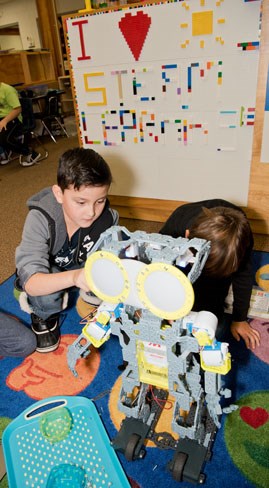Landing Trail students opened a $40,000 learning lab this week that should help them improve their skills in science, technology and the arts.
Gibbons student Darbee Morin is learning a lot by building robots.
The Grade 4 student was working with classmate Nathan Morgan to assemble a child-sized Meccano Meccanoid robot at Landing Trail School Monday.
“We’ve learned how to build the robots and we’ve learned how to code them,” Morin said, as she took an Allen wrench to a stubborn plastic motor, all while building reading and problem-solving skills.
“Some of us want to become scientists or engineers or heavy-duty mechanics,” she continued, and these projects help them practice the skills they need.
This particular robot, when finished, would be able to talk, dance, do kung-fu moves and – as part of a special ceremony Tuesday, roll through a commemorative ribbon, Morin and her classmates said.
“It’s really epic!” she said.
Morin’s robot was one of two that drove through a ceremonial ribbon at the Landing Trail Tuesday in Gibbons to officially open the new STEAM Learning Lab. The lab, a new spin on the school’s makerspace, is meant to encourage students to learn about science, technology, engineering, arts and math (STEAM) through hands-on projects such as robots.
The lab itself is an open area of the school’s library filled with some $40,000 in computers, VR goggles, robots, and toys, said teacher Amanda Langford, who organized it. It’s the only facility of its kind she knew of in Alberta found in a public school.
“For public education, it’s a huge step forward.”
STEAM learning
Langford said she built this collection of pricey technology over three years with the help of grants and donations from companies such as Best Buy St. Albert and North West Refining.
The STEAM lab is an evolution of the school’s makerspace, which Langford helped set up three years ago, said principal Darryl Propp. Instead of just setting kids loose in a room full of toys and tools in hopes they learn through play, the STEAM lab gives them a practical problem (e.g. “build a robot that will run through this ribbon”) to solve using tools and creativity.
“We want students to learn from what works and what doesn’t work. STEAM labs allow for that sort of scientific approach to learning.”
The plan is to have teachers create projects that cover multiple subjects and have students work on them in the lab for days or weeks, Langford said.
For her class, for example, she’s tasked each student with building a robot, which requires them to practice reading, math, programming and engineering. Other teachers might have students build a catapult to get Little Red Riding Hood around a spooky forest or use VR goggles to go on a virtual field trip to Antarctica to learn about temperature.
Students in the STEAM lab do most of their learning on their own, Langford said. While she’ll teach them how to do research or use specific items, such as JavaScript, students often turn to Google, YouTube or each other to find their answers.
“They do a lot of the problem solving themselves.
Langford said she saw a substantial increase in her students' reading abilities last year by teaching with a STEAM approach. Whereas few students would want to redo a worksheet, these kids would willingly re-read instructions and re-build projects to get them perfect.
“For them to do that naturally, you can’t teach that. It has to be something that’s super-engaging to them.”
Langford noted that you don’t need high-tech toys to make a STEAM lab – it’s what students do with the toys that’s important, not the toys themselves. She recommends that teachers who want to start such a lab begin with cheaper items (even cardboard works) and work their way up.
The aim of all this is to get students excited about education so they become lifelong learners, Propp said.
“If we teach students how they can learn themselves and learn from their mistakes and be reflective in their own learning, we’re doing one of the big jobs in training them to be the citizens of tomorrow.”




